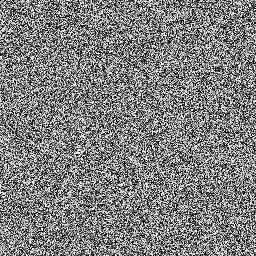Noise generation library for Common Lisp
-
noise-desc: Descriptor struct for parameters of a noise generator. The fields of the descriptor are enumerated below:-
generator: The noise generator function. The only required argument must be a list of coordinate components in the first position (a "point"). The coordinates should be in row-major order. Additional arguments may be passed as&keyparameters but must have defaults. -
generator-keys: A property list of arguments to pass togen, in addition to the coordinate list. This is where&keyparameters may be passed togen. -
size: The size of noise to generate when used inmake-generator,make-buf, etc. For 1-dimensional noise, an integer. Otherwise, a list of integer dimension sizes in row-major order. -
octaves: The amount of octaves of noise to consider. -
persistence: The weight of each octave, relative to the last. -
frequency-scale: Dimension scaling amount for each successive octave. May be a single number for uniform scaling, or a list of number to scale the corresponding entry insize. -
offset: The offset of the first data point of noise from the origin. -
width: The width of the sampled noise; e.g. a value of2will sample in the range [offset,offset+2).
-
noise point desc
Take a point point and a generator descriptor desc and return
the value of the noise at point.
make-generator desc
Take a generator descriptor desc and return a closure that returns each data
point of noise described by desc in row-major order.
make-buffer desc
Take a generator descriptor desc and return a buffer that contains the noise
described by desc.
uniform-perm n
Generate a random uniform permutation in the range [0,n) using the Fisher-Yates Shuffle.
with-generator name desc &body body
Execute the body body with the noise generator function described by desc bound to name.
with-buffer name desc &body body
Execute the body body with the noise generator buffer described by desc bound to name.
Noise generators are defined in cl-noise.gen.GENERATOR and reexported in cl-noise.gen.
All noise generators output values in the range [-1, 1]
uniform &rest unused
Uniform random noise.
perlin point &key (perm +ken-perlin-perm+)
Takes a point point and a uniform permutation of integers [0-255] and returns the value of
perlin noise at point.
Uses original Ken Perlin Permutation by default.
simplex point &key (perm +ken-perlin-perm+)
Takes a point point and a uniform permutation of integers [0-255] and returns the value of
simplex noise at point.
Uses original Ken Perlin Permutation by default.
To build examples:
$ ./build.sh $EXAMPLE
$ ./build.sh png # build png exampleCreate a PNG of 2 dimensional noise.
Usage: png OPTIONS FILE [FILE ...]
Available options:
-h, --help Print this help text
-s, --size ROWS,COLUMNS
The size of the noise as a comma-separated list in row-major order [Default: (3 3)]
-o, --octaves ARG Number of octaves to use for perlin noise [Default: 1]
-p, --persistence ARG Weight of each octave relative to the last [Default: 0.5]
-w, --sample-width ARG Noise sample size [Default: 8.0]
-g, --generator ARG Specifies the noise generation function
One of [`UNIFORM', `PERLIN', `SIMPLEX'] [Default: perlin]
-k, --ken-perlin-perm Whether to use Ken Perlins original permutation
--offset Y[,X] Offset of first noise data point from origin [Default: (0 0)]
- 256x256 uniform noise to "image.png":
$ ./png -g uniform --size 256,256 "image.png"- 256x256 perlin grayscale, 3 octaves to "image.png":
$ ./png -g perlin --size 256,256 --octaves 3 "image.png"Output 1 or 2 dimensional noise as text to standard out.
Usage: text OPTIONS [FILE ...]
Available options:
-h, --help Print this help text
-s, --size ROWS[,COLUMNS] The size of the noise as a comma-separated list in row-major order
[Default: (3 3)]
-o, --octaves ARG Number of octaves to use for perlin noise [Default: 1]
-p, --persistence ARG Weight of each octave relative to the last [Default: 0.5]
-w, --sample-width ARG Noise sample size [Default: 8.0]
-g, --generator ARG Specifies the noise generation function
One of [`UNIFORM', `PERLIN', `SIMPLEX'] [Default: perlin]
-k, --ken-perlin-perm Whether to use Ken Perlins original permutation
--offset Y[,X] Offset of first noise data point from origin [Default: (0 0)]
- 4 values of uniform noise:
$ ./text --size 4 -g uniform0.7695440824515019 -0.7537826533967542 0.6109767621066111 0.4594674938062311
- 4x4 values of simplex noise offset to (5,5) using the Ken Perlin permutation:
$ ./text --size 4,4 --offset 5,5 -g simplex -k | column -t0.33723438 0.6889363 0.2889931 0.6488647
0.49733528 0.2889949 -0.3244326 -0.6220379
0.5779881 0.0000005150496 0.49821177 0.07493882
-0.32443157 -0.4982115 -0.03746941 -0.13081408

